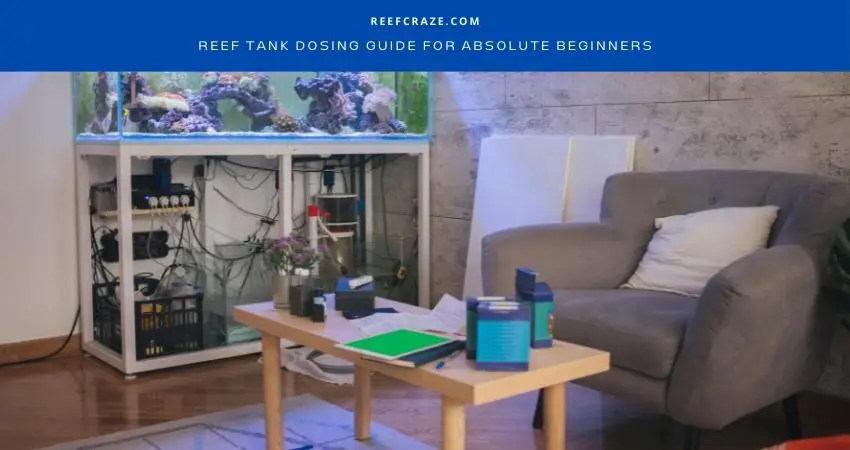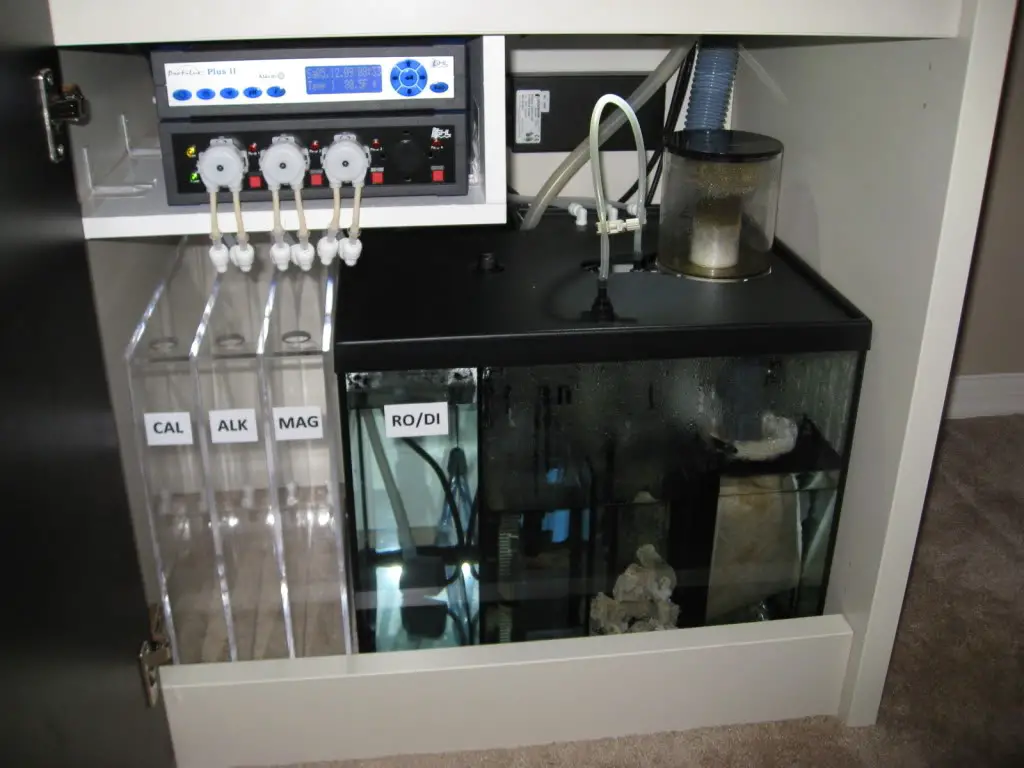If you are a beginner reefer having concerns about dosing your reef tank, you are in the right place. When a hobbyist starts reef keeping, everything seems overwhelming since it is no piece of cake to maintain a reef aquarium.
It is alright for you to be nervous about keeping your corals healthy. But the only way to be successful with that is to keep your tank water parameters stable. When left unattended, they fluctuate, deteriorating the water condition and affecting the animals. Now, this is where reef tank dosing comes into the scene.
Dosing an aquarium refers to introducing trace components like Magnesium, Alkalinity, and Calcium to the tank water. When your corals grow by increasing their consumption, only water changes are not enough. You have to go for dosing, which you can do either manually or by using an automated liquid dosing pump. You can also try changing salt or getting a calcium reactor.
A reef tank dosing guide will follow the rest of today’s article. So, without further ado, let’s get started!
Why Is Reef Tank Dosing Necessary?
Everything you need to do about or for your reef tank directly or indirectly involves your sea animals’ health. Your corals need the water parameters to stay stable within a particular range every day.
For example, calcium needs to be between 400 and 450 ppm. It cannot fluctuate dramatically. Calcium helps corals form their skeletal structures, salient for their growth and health.
The same goes for Alkalinity and Magnesium. Your aquatic pals have to have them within specific ranges to flourish. The optimum level for Alk is 8.5, but anywhere between 7.5 and 11 will do. As for Magnesium, you should aim to keep it above 1300 and below 1500.
But as time goes on, water changes cannot meet the requirements sufficiently. Eventually, you will need to switch to dosing or supplemental dosing.
Additional Read:
- How often to dose calcium in reef tank
- How to lower calcium in reef tank
- How to raise calcium in reef tank
- How to dose Kalkwasser in a Reef Tank
When Should I Start Dosing My Reef Tank?
The prime elements get depleted as you bring more corals into your tank while the existing ones grow. That is why water changes cannot make much of a difference.
Imagine there is a locked room with a single animal. It can live there for some time breathing in the oxygen that occupies the place. But as that creature grows, it needs more oxygen.
Now, if you open the door sometimes to let more oxygen in, it will not work. Such is the case with water changes. They cannot sustain life. Thus, you have to pump more oxygen into the room for your animal to stay alive. Hence, you need dosing.
When you cannot do anything by performing water changes, regular tank dosing will keep the water parameters as stable and close to the natural environment as possible.

Reef Tank Dosing Guide
The guide will walk you through the techniques mentioned in the beginning. Let’s explore them one by one.
Changing Salt
It is the easiest method for dosing a reef tank. You can use salt mixes like Red Sea Coral Pro for the thriving corals.
Try using a salt mix and perform weekly tests for Mag, Cal, and Alk to see their ability to maintain the required levels. It will buy you several months or even a year based on the increase in demand.
I reviewed a few top of the line reef salts in this article.
Adding Manually
Once the salt cannot keep up with the demand, you should resort to supplemental dosing. It will take several times to acquire, but it is easy anyway.
You have to buy a 2-part starter kit that contains all the things needed for dosing. It has simple instructions to follow. Preparing it is also convenient. Besides, it will be long-lasting if you have a small demand.
If the term ‘2-part’ concerns you, it is nothing. The formula has granules to make liquid solutions for Magnesium, Alkalinity, and Calcium.
The only but significant downside of the method is that you have to dose your tank every single day. If you do not stay home for some days, you will need to have someone else do it. But if they cannot do it properly, there may be consequences.
Automated Dosing
Almost every reefer’s go-to solution is automated reef tank dosing. When manual adding becomes your headache, it would be wise to switch to automated dosing.
Automated dosing pumps drive the calibrated amounts from the solution jar into your reed tank. They will do it whenever and however you want. You set it, and the rest will be on the pump.

There are a couple of methods to move forward with the procedure.
- You can buy a starter kit featuring dosing pumps, or
- Purchase a standalone pump system to operate it with a 2-part starter kit.
A Calcium Reactor
It is not for a new reefer. So if you are experienced and have a large aquarium, you can get a calcium reactor for dosing.
Dosing with liquid mixes is enough as long as you have an aquarium with a capacity of fewer than 150 gallons. If not, a calcium reactor can be your savior (but at a price).
Calcium reactors are tubes full of pieces of dead coral skeletons with Carbon Dioxide. The gas dissolves the bones so that the trace components can mix with the tank water.
When the water drips into the tank at a rate fixed by you to fulfill the demand, a Ph controller will monitor the system. Since it melts dead corals, the ions injected into the dead corals will release for the new ones.
Things To Take Note Of
You should dose Alkalinity and Calcium separately during dosing. If you dose together, it will cause precipitation, creating white clouds in the tank.
In the simplest terms, precipitation is the portion of Calcium undoing its dissolving from the aquarium water. Once it happens, the corals will not be able to take in the Calcium.
You can prevent this by setting up a reef tank dosing guide or routine in the following ways.
- If the quantity is not much, then dose Alkalinity in the mornings since most of it is absorbed during the daytime. Afterward, you can dose the Calcium in the evenings.
- If you own an automated dosing device or your reef tank demands a considerable amount of dosing, follow this approach: Dose the Alkalinity on the 12 odd hours and the Calcium on the 12 even hours.
- You should dose the Magnesium as required by your tank to maintain the optimum parameter. However, do not go above 100 PPM/Day to increase the volume.
Frequently Asked Questions
Can Increasing Alkalinity Decrease Calcium?
Let’s say you have added a lot of Calcium to the tank water. It will mitigate the alkalinity level due to its precipitation in the aquarium. Likewise, if you increase Alkalinity by a large margin, it will also cause calcium reduction.
Is It Worthy To Invest In A Calcium Reactor?
If you have a regular-sized reef tank, an affordable 2-part solution such as BRS Bulk Pharma should be enough. You will not need to invest in a calcium reactor.
Contrarily, a calcium reactor will serve you right if you are in either of the following circumstances.
– You own a gigantic or high-consumption aquarium.
– You use a high-end, costly 2-part solution.
– You are okay with the long payback horizons.
Finally, if you are into gears and gadgets with the affordability to have a reactor, then go for it, by all means. It will be well worth your investment. It is never a waste to spend money on the stuff you love and enjoy.
Does A Calcium Reactor Have Anything To Do With The pH Level Of My Reef Tank?
Yes. It will cause the average pH level to drop slightly inside the display.
Where Should I Place A Dosing Pump Inside My Reef Tank?
Ideally, you should place it above your sump system where it is not open to spills or splashing. You can mount it horizontally or vertically.
When you affix the tubing, insert it carefully over your connector, where it cannot go any further.
Final Words
Do not start hurrying to dose your reef tank after getting one. It will take some time before you have to get prepped for it. Some reefers never have to dose their tanks at all.
But if you do, and when you do, you have to learn about the process I laid out in this reef tank dosing guide.
I find automated dosing the most effective and time-saving of all the methods. It is also the go-to approach for every beginner. When you do it several times and become confident, you can easily meet the demand of your tank animals.
Remember to test once in a while and jot down the results in your journal. It will help you keep track of the declining parameters and take steps accordingly.
That is enough about reef tank dosing guide 101. Thank you for reading!
